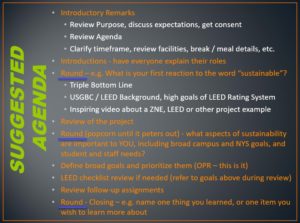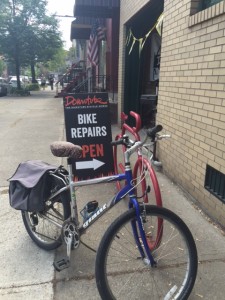
Awesome Charrettes: Part 3 – Logistics
” a goal without a plan is just a wish”
This quote is not just about the results of the charrette meeting. It is about planning the meeting itself. Take the time to plan, lest you invest the time and effort and gain little.
We must understand the power of planning in achieving the awesome charrette, beginning with the mundane yet imperative topic of logistics. Logistics include invitations and room set up. Though they may sound dull, well planned logistics are important for setting the tone of the meetings, and for gaining the full potential from the work. Think of them as the set, lighting, costumes, and sound in a successful play or musical. The story could be told without those elements, yet well-done these supporting elements help to project the story and underscore the lessons, the excitement and the experience.
Pre-meeting:
In a world with never-ending meetings, a small, key, core group of people will meet to define goals, and set the tone for achievement beyond compromise for this project. If you think win/win/win is a fool’s fantasy, think again. Yet we need to plan to achieve this level of success.
Timing – Make sure this meeting happens exceptionally early, potentially before budget confirmation. The intent is to define the information that should guide design, so pre-schematic, certainly. Benefits can occur with a meeting later in the process as well, but an earlier investment of time and thought will carry benefits through a greater portion of the project.
Invitations – You must identify who should attend. Be careful as there is a fine balance between including every stakeholder under the sun and including just those that can expand the conversation in a useful, effective way, as well as work with the other attendees to find solutions. Pick your obvious half-dozen players, and then ask each of them for their inputs into who to include. Assess what you already know about the project to identify possible items for discussion, which may also inform the attendee list. If there is potential for shared community space usage, for example, invite a rep from those potential user groups. If there is a pool, invite someone who can speak to the energy, water, safety and maintenance issues inherent in pools.
Do a doodle poll and plan 3-5 hours, and clarify that all invitees should attend the whole meeting. Call the invitees. Get RSVPs. Know who will be there, and figure out how to make adjustments for coverage of information if a subject matter expert (SME) cannot attend.
Expectations – Define the agenda, including goals for the meeting, identifying the roles of each person in the room, and clarifying that the LEED (or other system) checklist will NOT be used to define goals for the project or to set the agenda.
Meeting set up:
There is nothing worse than talking about human health and wellbeing in a basement conference room that has no windows. Or in defining greener goals for a project while eating fast delivery pizza on polystyrene plates. Do all you can to make this meeting the exemplification of excellence.
Daylight and air – A large enough room with access to daylight and views is key for any long meeting, especially one about, say, daylight and views. If you cannot find such a room, your last resort is to use the below-par room you are in, actively, as an example of what we don’t want for the building project.
Positioning and roles – The facilitator should not sit at the head of the table, but a bit off to the side, allowing a more King Arthur’s Court of equality. Choose a note taker early in the meeting (it cannot be the facilitator) and designate an info searcher as well.
Breaks – In a collaborative meeting, breaks can be at personal choice times, but ensure you also schedule in a reasonable break each 1.5 – 2 hours. Be prepared to call for a stretch break when things get tense or stuck. A facilitator reads the room and commits to holding people to the agreed time for these breaks.
Food – Sustenance should sustain! Include some real protein, a few natural sugars, and avoid highly processed bars, even if they claim they are “healthy”. Source local goods if possible. Exemplify the quality you seek.
Tools – Needs for this meeting may include whiteboard, markers, tear-off paper easels, a working projector and screen or smart board and proper connections to laptops including internet connections. This is a working meeting. Make sure, prior to the meeting, that all tech works and outlets are present or to provide extension cords so attendees can take notes electronically. Check the dry erase pens. Taking real-time, handwritten notes embeds visual reminders in people’s heads. You can take a photo of the notes for the record, and cross check the note takers’ work as well. Have a separate place (board or visible sheet of paper) for the bike rack, to capture ideas that need more time or another meeting.
Meeting, unfolding:
The challenge lies in moving the work forward while encouraging the integrated and iterative thought process that will inform success.
Meeting agenda – I have included a photo of a sample agenda for a programming charrette. Distribute the agendas prior to the meeting, and make every attempt to include the list of invited (and accepting) participants in that outreach so people know when they will be working with.
 Checklists – Do not use a LEED checklist on the agenda, or to create the agenda topics. Any such checklist will inadvertently encourage linear thinking, and make it difficult to discuss the broader and integrated benefits in systems approaches. It also limits the discussions. LEED is not the world of possibilities. Think of this comparison “For LEED we must obtain minimum 14% better than current code, which uses ASHRAE 90.1 2010, and we need to determine what systems can get us there and how we will approach the modeling component” and “The campus has a goal of carbon neutrality in 2035. Though this is some time in the future, how can this building help move the campus toward that goal?” This second question allows discussion of a huge range of thought, including transit to the building, occupant comfort, plug loads, cleaning that affects air quality and ventilation, material selections, and more. Seek win/win/win and allow innovation to occur.
Checklists – Do not use a LEED checklist on the agenda, or to create the agenda topics. Any such checklist will inadvertently encourage linear thinking, and make it difficult to discuss the broader and integrated benefits in systems approaches. It also limits the discussions. LEED is not the world of possibilities. Think of this comparison “For LEED we must obtain minimum 14% better than current code, which uses ASHRAE 90.1 2010, and we need to determine what systems can get us there and how we will approach the modeling component” and “The campus has a goal of carbon neutrality in 2035. Though this is some time in the future, how can this building help move the campus toward that goal?” This second question allows discussion of a huge range of thought, including transit to the building, occupant comfort, plug loads, cleaning that affects air quality and ventilation, material selections, and more. Seek win/win/win and allow innovation to occur.
Rounds – Include rounds in the agenda to ensure inclusion of everyone, and that each large point of decision gets verbal commitment. There is a massive commitment with verbal agreement in a room with other people as witness. This will help the process continue and succeed. The qualifier is that the facilitator and team will have to work through any sticking points, where people have issues that require additional discussion.
 Bike rack – You will need to “park” some items for deeper discussion or research. Address this list either in this meeting, if time permits, or in a follow-up meeting or communication. The bike rack is an important time-management and engagement tool and the facilitator should briefly review it at the end of the meeting as part of the departure process.
Bike rack – You will need to “park” some items for deeper discussion or research. Address this list either in this meeting, if time permits, or in a follow-up meeting or communication. The bike rack is an important time-management and engagement tool and the facilitator should briefly review it at the end of the meeting as part of the departure process.
Ready to ride.
Closing – This will include a review of assigned tasks, acknowledgement of the bike rack items, thanks to the participants for their attention, expertise and passion, and time for a closing round. Engage in this proper departure process to close out the meeting with clear positioning for ongoing work. The closing round can be a simple goodbye from each attendee, or the facilitator can ask a specific closing question such as “name one thing you learned today” or “what goal excites you the most”. Remind the attendees that they will receive meeting notes within a week, including reminders of their tasks, and that this is merely the foundation meeting for a wonderful project.
Let the actors exist on a blank stage with no amplification, no makeup and no ushers to escort people in and the story will still be told, but may not take root in the memory and passion of the attendees. Help these goals to take root with strong logistical planning.
Be greener,
Jodi
Be the first to like this post (no login required)

